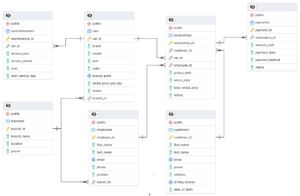Inserting, Updating, and Deleting Data in PostgreSQL: A Comprehensive Guide

PostgreSQL is a powerful, open-source relational database system that provides robust features for managing data. One of the essential aspects of working with PostgreSQL is the ability to insert, update, and delete records efficiently. In this guide, we will explore how to manipulate data in PostgreSQL using SQL commands, best practices, and performance optimization tips.
1. Inserting Data into PostgreSQL Tables
The INSERT statement allows you to add new records to a table. Here’s a basic syntax:
INSERT INTO table_name (column1, column2, column3)
VALUES (value1, value2, value3);
Example :
INSERT INTO customers (first_name, last_name, email, phone, address, date_of_birth)
VALUES ('John', 'Doe', 'john.doe@example.com', '123-456-7890', '123 Elm Street', '1990-05-15');
Best Practices for Inserting Data:
- Use Bulk Inserts: Instead of inserting one row at a time, batch multiple rows for better performance.
- Specify Columns: Always specify column names to avoid errors when table structures change.
- Use RETURNING Clause: Retrieve generated values like serial primary keys.
INSERT INTO customers (first_name, last_name, email, phone, address, date_of_birth)
VALUES ('Jane', 'Smith', 'jane.smith@example.com', '987-654-3210', '456 Oak Avenue', '1985-08-20')
RETURNING customer_id;
Updating Data in PostgreSQL
The UPDATE statement modifies existing records in a table based on a specified condition. Here is the basic syntax:
UPDATE table_name
SET column1 = value1, column2 = value2
WHERE condition;
Example:
UPDATE customers
SET phone = '555-123-4567'
WHERE customer_id = 1;
Best Practices for Updating Data:
- Always Use WHERE Clause: Avoid accidental updates to all rows.
- Use Transactions: Ensure data integrity by wrapping updates in a BEGIN and COMMIT transaction.
BEGIN;
UPDATE customers SET address = '789 Pine Road' WHERE customer_id = 2;
COMMIT;
- Use RETURNING Clause: Fetch updated values immediately.
UPDATE customers SET phone = '222-333-4444' WHERE customer_id = 2 RETURNING *;
3. Deleting Data in PostgreSQL
The DELETE statement removes records from a table based on a specified condition. The basic syntax :
DELETE FROM table_name
WHERE condition;
Example:
DELETE FROM customers WHERE customer_id = 3;
Best Practices for Deleting Data:
- Always Use WHERE Clause: Prevent deleting all rows unintentionally.
- Use RETURNING Clause: Get deleted row data if needed.
DELETE FROM customers WHERE customer_id = 4 RETURNING *;
- Use TRUNCATE for Large Deletions: If you need to delete all rows, TRUNCATE is faster and resets sequences.
TRUNCATE TABLE customers RESTART IDENTITY;
4. Transactions and Rollbacks
To ensure consistency, use transactions when modifying data. If an operation fails, you can roll back changes.
BEGIN;
UPDATE customers SET phone = '999-888-7777' WHERE customer_id = 5;
ROLLBACK; -- Undo the update
Conclusion
In this guide, we covered how to insert, update, and delete data in PostgreSQL efficiently. By following best practices, using transactions, and leveraging performance optimization techniques, you can manage your database effectively.
Stay tuned for more PostgreSQL tutorials, and let us know if you have any questions in the comments!
